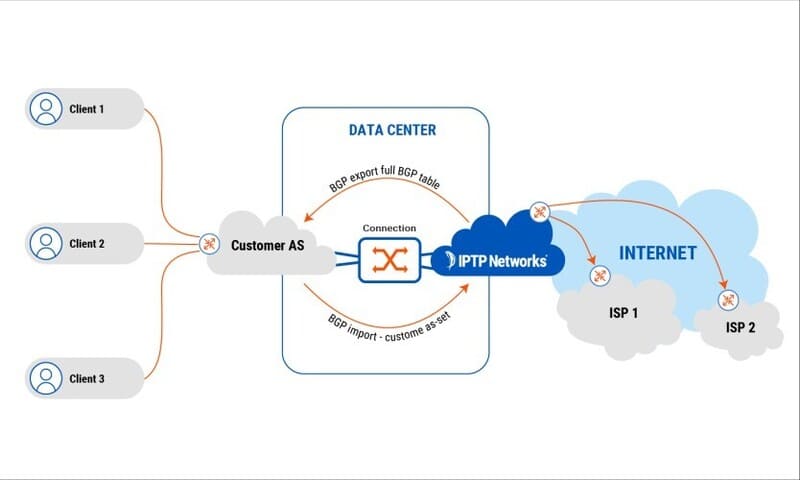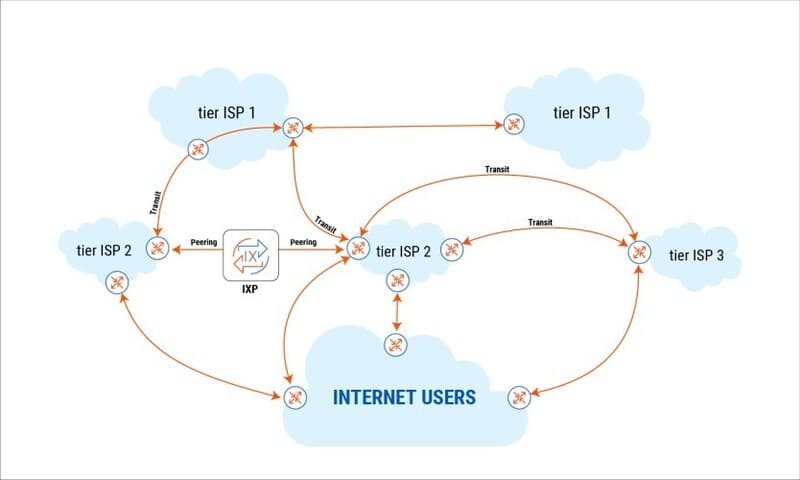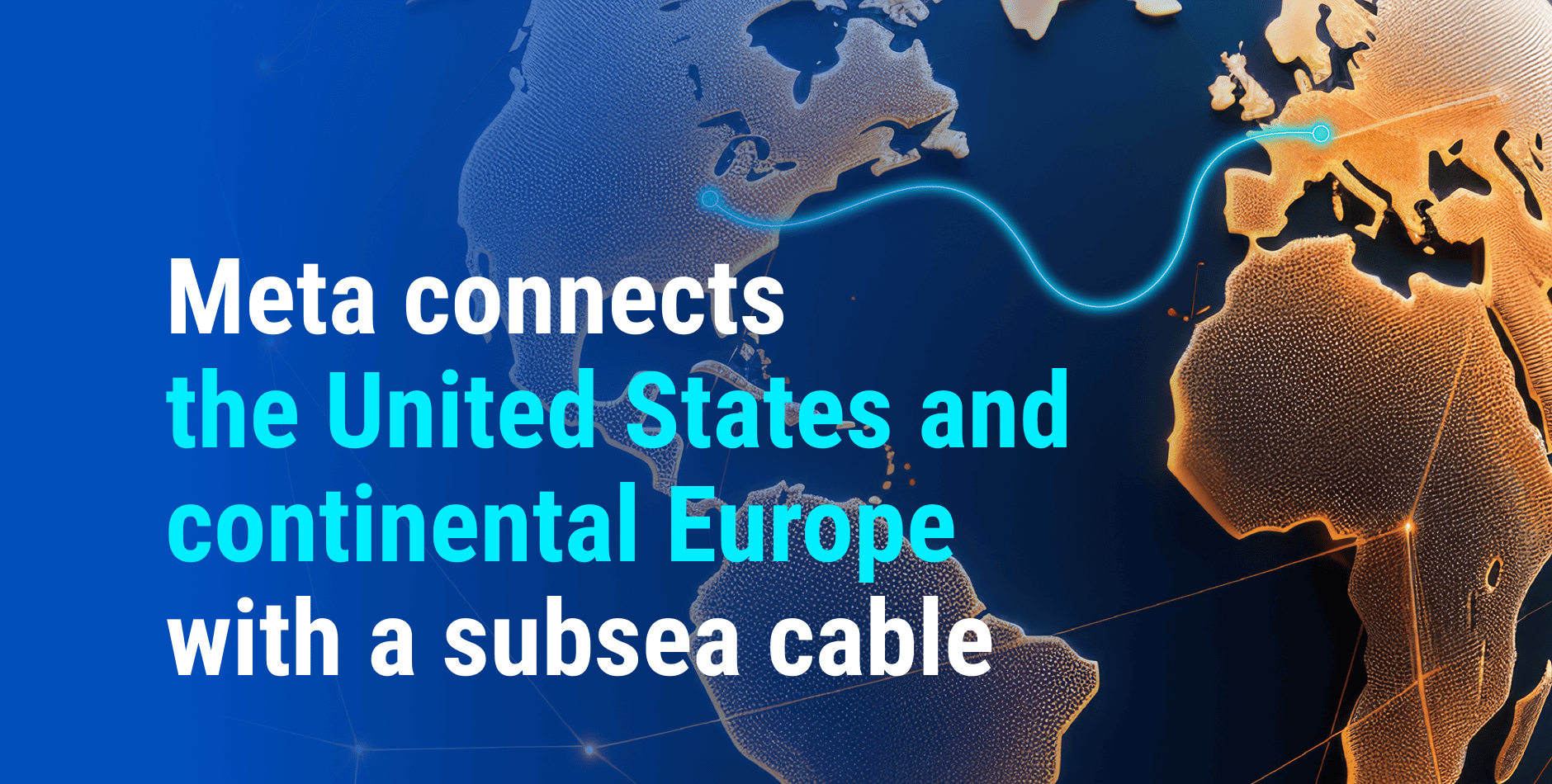Um guia para iniciantes em rede: O que é IP Transit?

Todos nós sabemos que a magia da Internet é como você pode rolar em seu telefone e ver as últimas notícias do outro lado do globo. Mas você sabe exatamente como isso funciona?
Neste artigo, IPTP Networks revelarão um dos segredos que permitem o funcionamento da Internet – IP Transit.
Como funciona a Internet
Uma rede é composta por um cluster de dispositivos conectados que podem se comunicar entre si. Para se conectar a todos os dispositivos do planeta, a Internet não é apenas uma grande rede, mas uma série de várias redes combinadas.

Para que qualquer informação seja enviada ou recebida na Internet, ela precisa ser dividida em pequenos pacotes de dados e enviada por uma ou várias redes interconectadas antes de ser reunida no destino final.
Quando as redes interconectadas concordam com um arranjo de troca de tráfego de dados, os pacotes de dados podem se mover do ponto A para o ponto B pela Internet. Um dos tipos mais comuns de arranjo é o IP Transit.
O que é IP Transit?
Definição de IP Transit
Os pacotes de dados devem passar, ou em termos de rede – trânsito, por uma série de redes de terceiros antes de chegar ao local de destino.
O IP Transit é um serviço em que um Provedor de Serviços de Internet (ISP) permite que o tráfego percorra sua rede para chegar ao restante da Internet. O serviço IP Transit usa o protocolo BGP para fornecer acesso de rede a toda a Internet. Em outras palavras, um cliente de IP Transit deve pagar ao provedor de serviços de IP Transit para obter acesso à extensa tabela de roteamento de Internet BGP do provedor.

O IP Transit está disponível para aqueles que possuem um Sistema Autônomo e podem estabelecer roteamento usando o Border Gateway Protocol.
Sistema Autônomo (AS) / Número do Sistema Autônomo (ASN)
O Sistema Autônomo (AS) representa um ISP ou uma grande organização com conexões independentes a outras redes. Cada AS possui um Número de Sistema Autônomo (ASN) registrado exclusivo como identificador para se comunicar com outros ASs.
Por exemplo, IPTP Networks é um AS com o ASN 41095, e nossa rede se conecta a nossos clientes e outros ASes ao redor do mundo.
Somente aqueles que operam seu próprio AS, ou seja, possuem um ASN atribuído, estão qualificados para o serviço de IP Transit.
Protocolo de Gateway de Fronteira (BGP)
O serviço IP Transit é baseado no Border Gateway Protocol (BGP). O BGP é usado pelo AS para interagir uns com os outros e permitir que o IP Transit aconteça por meio de informações de acessibilidade.

Para que os ASes formem uma conexão e troquem tráfego, eles usam o BGP para anunciar as informações de acessibilidade, incluindo duas listas com endereços IP controlados pelo AS remetente e pelo AS receptor. O BGP determina o melhor caminho para encaminhar um pacote de dados e direciona qual rota ele deve seguir para chegar ao seu destino.
Sem ASN e BGP, a troca de tráfego de internet entre essas grandes redes seria impossível.
Camadas de Provedores de IP Transit
Os Provedores de IP (ISPs) são definidos em três níveis de camada com base em seus recursos.
- Os ISPs de nível 1(Tier 1) são a backbone da Internet e têm uma presença global. Eles não pagam por trânsito e peer (conectam e trocam dados) entre si gratuitamente. As redes Tier-1 conectam ISPs Tier-2 e Tier-3 (nível inferior) e cobram aos ISPs de nível inferior uma “taxa de trânsito” para usar suas redes.
- Os ISPs de nível 2 têm redes extensas de alcance regional ou nacional. Apenas alguns ISPs de Nível 2 são capazes de atender consumidores em muitos continentes. Os provedores de Nível 2 fazem par com outros de Nível 2 para minimizar os custos de IP Transit, mas ainda precisam comprar o IP Transit de ISPs de Nível 1 para alcançar o restante da Internet.
- Os ISPs de nível 3 são provedores de serviços regionais cujas redes cobrem algumas nações ou sub-regiões. Os ISPs de nível 3 compram apenas tráfego da Internet. Para evitar os altos custos do trânsito IP de Nível 1, eles frequentemente compram o trânsito de IP de provedores de Nível 2. Os ISPs de nível 3 geralmente não têm clientes de trânsito e geralmente se preocupam com os mercados corporativos e consumidores locais.
A hierarquia do ISP classifica aqueles com nível superior como upstream e aqueles com nível inferior como downstream. Por exemplo, quando o tráfego flui de um Tier-3 para um Tier-2, ele está se movendo a montante (upstream). Nesse caso, o ISP com nível inferior (Tier-3) é um provedor downstream que compra o serviço IP Transit do ISP Tier-2 – um provedor upstream. ISPs com Tier semelhante, por exemplo ISP Tier-1 e Tier-1, são parceiros de mesmo nível.
Como funciona o IP Transit
O IP Transit conecta a rede de um cliente à Internet e fornece um caminho claro para o tráfego chegar ao seu destino. O cliente paga uma taxa de trânsito para se conectar a um local – geralmente conhecido como POP (Point of Presence) – do provedor. O provedor garantirá que o cliente possa acessar qualquer servidor na Internet, assim como todos os servidores da Internet agora podem acessar o servidor desse cliente.
O serviço de IP Transit normalmente é cobrado por megabit por segundo por mês. Um SLA (Service Level Agreement) é geralmente incluído no serviço de IP Transit. O SLA especifica a qualidade do serviço e os termos de reembolso no caso de um cliente não conseguir acessar a Internet por um longo período de tempo.
Dependendo do tamanho e do nível da rede, o provedor precisará pagar por uma ou mais redes maiores para fluir o tráfego do cliente para o destino desejado por meio do trânsito upstream.
IP Transit vs IX Transit vs DIA – O que escolher?
Além do IP Transit, existem dois outros serviços de conectividade para fornecer acesso à Internet: IX transit e DIA.

O IX Transit é um tipo de serviço de peering público através do Internet Exchange Point (IXP). Um IXP serve como um ponto de conexão onde as redes dos ISPs podem se conectar e trocar o tráfego da Internet. O IX Transit é um IP Transit parcial que permite que o tráfego alcance redes de peers e ISPs downstream para uma latência ideal.
DIA – significa Direct Internet Access – funciona da mesma forma que o IP Transit. DIA é o serviço de internet mais comum para aqueles que não possuem um ASN. É muito mais barato que o IP Transit, no entanto, seu tempo de inatividade e qualidade deixam muito a desejar.
Orçamento, número de peers, bem como seu nível de dependência de latência são alguns dos fatores que você pode considerar ao escolher IP Transit, IX Transit ou DIA.
Se você não tem um ASN atribuído e procura apenas um serviço de Internet simples e barato para uso geral, o DIA seria a escolha ideal.
O IX Transit é adequado para aqueles que usam aplicativos sensíveis à latência e preferem ser práticos com seu roteamento de tráfego e otimização de rede dentro de um orçamento limitado.
Para que sua empresa alcance e se conecte com qualquer empresa em qualquer lugar do mundo, o IP Transit é essencial, independentemente do método que você preferir para acessar a Internet.
Deixe a IPTP Networks ajudarem na sua decisão de conectividade!
Precisa de mais orientação sobre como escolher o serviço de acesso à Internet certo para o seu negócio?
Nossa equipe de especialistas está pronta para ajudar com suas necessidades de rede. Contacte a IPTP Networks através do nosso Live Assistant ou envie-nos um email para
